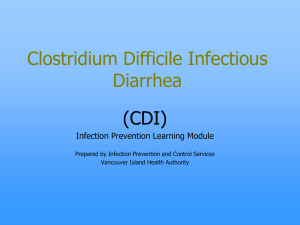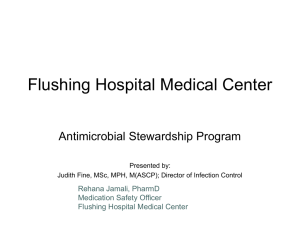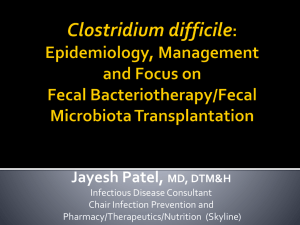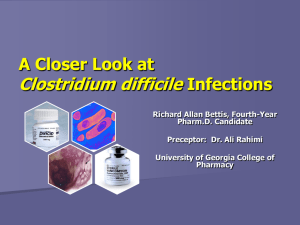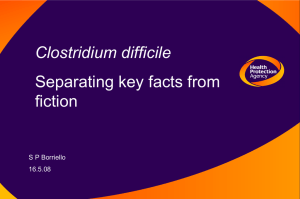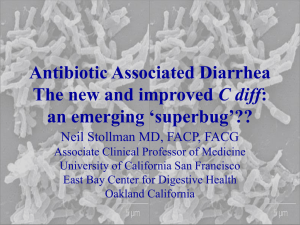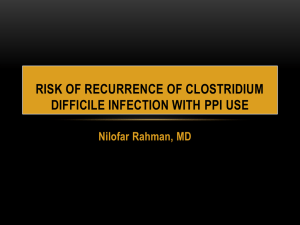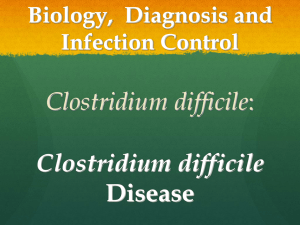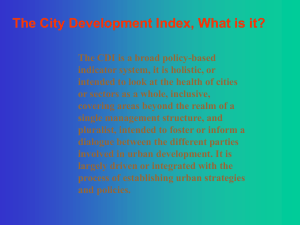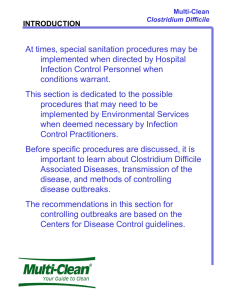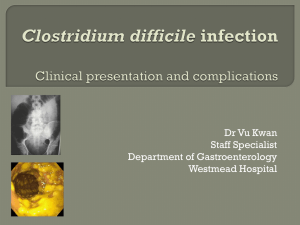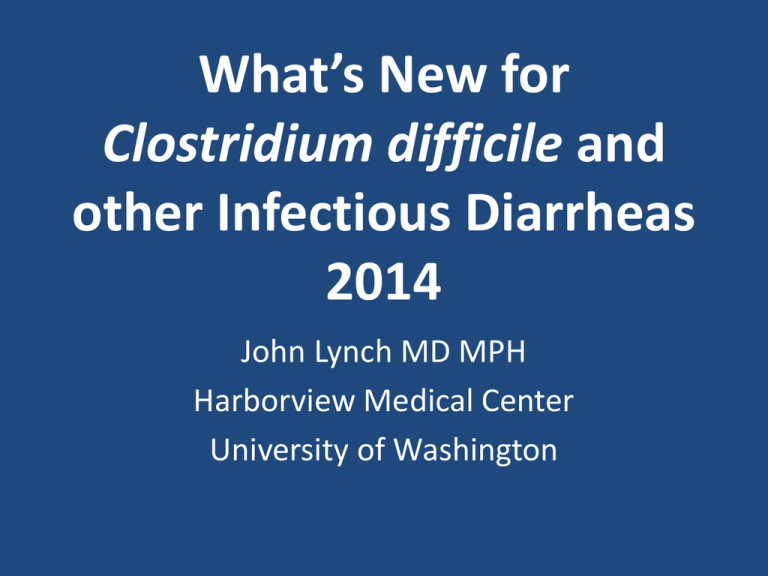
What’s New for
Clostridium difficile and
other Infectious Diarrheas
2014
John Lynch MD MPH
Harborview Medical Center
University of Washington
http://bit.ly/1wb7KOz
Airline food linked to illnesses
May 20, 2005
HONOLULU, Hawaii (AP) -- Contaminated carrots served on several
flights out of Honolulu likely caused 45 people to suffer food
poisoning across 22 states, Japan, Australia and American Samoa, a
state epidemiologist said Thursday.
Airline food linked to illnesses
May 20, 2005
The outbreak has sparked one lawsuit, filed Thursday, against airline
caterer Gate Gourmet Inc., which included the carrots in meals
served last August 22-24.
The company, based in Virginia and Switzerland, was sent a warning
letter by the federal FDA on April 21 citing violations found in a
February inspection of its Honolulu facility -- such as a "pink slimy
substance" dripping onto the conveyor of the pot washing machine,
live cockroaches and flies, and mold growing on the windows of a
refrigerator.
Gate Gourmet provides meals for Northwest, Delta, United,
Hawaiian and Aloha airlines.
Pathogenic Mechanisms of Diarrhea
• Toxins:
– Preformed: S aureus, C perfringens, B cereus
– Formed in the intestine by ingested bacteria:
• Stimulate intestinal secretion: V cholerae, enterotoxigenic E
coli
• Cytotoxins: C difficile, Shigella, enterohemorrhagic E coli
• Invasion: Shigella, Salmonella, Campylobacter,
Yersinia
• Disruption of enterocytes leading to decreased
absoprtion: Giardia, Cryptosporidium
Fred Buckner MD
Diarrhea is # 2 highest ID mortality
with 2.16 M deaths/year
What is # 1?
A.
B.
C.
D.
E.
HIV/AIDS
Malaria
Tuberculosis
Lower respiratory infections
MRSA
What are the four leading causes of
infectious diarrhea in children <2
yrs in developing countries?
1.
2.
3.
4.
Rotavirus
Cryptosporidium
ETEC
Shigella
Global Enteric Multicenter Study (GEMS). Lancet 382:209, 2013
Intestinal Fluid Balance:
Site
L In / L Out
Efficiency
Jejunum
9-10/4-5
50%
Ileum
4-5/3-4
80%
Colon
1.5/1.4
95%
Stool
100-200 ml
98-99%
Diarrhea occurs when reabsorption decreases to around 9596%; minor changes result in major fluid losses
Case 1
• 36 y/o man has crampy abdominal pain, bloody
diarrhea x 1 day, and fever (102). He just
returned from a 1 month trip to India and
Thailand.
– What is this syndrome?
• Dysentery
– What else do you want to know about the patient?
•
•
•
•
•
HIV status?
Other medications? Antibiotics? Immunosuppressives?
Sexual contacts? (Could this be proctitis?)
Foods? (e.g. shellfish are risk for vibrios)
Other travelers with similar illness?
Is the pathology in the small bowel or
colon?
Small Bowel
Colon
Symptoms
Nausea, bloating,
cramping, gas, weight
loss
Fever, rectal pain,
frequent painful stools
Physical signs
Dehydration,
orthostasis, decreased
skin tugor
Fever, abdominal pain
Diarrhea
Large volume, watery
Small volume, pasty,
and/or blood, mucous
Microscopic exam of
stool
Without inflammatory
cells or blood,
with/without mucous
Inflammatory cells,
blood, mucous
Agents of diarrhea based on localization
within the intestine
Small Bowel
Colon
Bacteria
E. coli (ETEC, EPEC), Staphylococcus
aureus, Clostridium perfringens,
Bacillus cereus, Vibrio cholera,
Salmonella sp.
Campylobacter sp.,
Shigella sp., Salmonella sp., Clostridium
difficile, Yersinia sp.,
STEC (0157:H7),
Vibrio parahemolyticus, Plesiomonas
shigelloides,
Aeromonas hydrophila
Viruses
Rotavirus
Norwalk agent
Astroviruses
Caliciviruses
Cytomegalovirus
Adenovirus
Parasites
Giardia lamblia, Cyclospora
cayatenensis, Cryptosporidium
parvum, Microsporidium sp.,
Dientamoeba fragilis, Isospora belli
Entamoeba histolytica,
Balantidium coli
Case 1: (Scenario A)
Pt is otherwise healthy and taking no
medications. Stool studies are sent.
– Do you want to give empiric treatment?
• What antibiotics?
– Azithromycin 500 mg PO QD x 3 days
(Note: C. jejuni resistance to FQs is
widespread)
• Antimotility drugs?
– Usually not for dysentery, although they are
probably safe if antibiotics are being coadministered
Recommended treatments
• Shigella spp.
– Cipro (or other FQ) 750 mg PO QD x 3 days
• Campylobacter jejuni
– Azithromycin 500 mg PO QD x 3 days
• Salmonella (non-typhoidal)
– Mild disease: none*
– Possible bacteremia:
• Levo (or other FQ) 500 QD
– 7 days if immune competent
– 14 days if immune suppressed
• Aeromonas, non-cholera vibrios, Yersina: treat
as for Shigella
* Onwuezobe et al. Cochrane Database Syst. Rev. 2012
Case 1: Scenario B
Instead of India, the patient just returned
from Germany (June, 2011)
– He has dysentery symptoms but afebrile
• What are you concerned about?
– STEC (shiga-toxic producing E. coli)
• Including non-O157 serotypes (e.g., O104)
• How do you treat?
– Supportive. No antibiotics!
Germany outbreak, May 2011
Shiga toxin-producing E. coli (STEC)
• By July, 2011:
–
–
–
–
4000 illnesses
823 pts with hemolytic uremic syndrome (HUS)
50 deaths
71% females
• Five confirmed travel-associated cases in USA.
• Cause of outbreak:
– E. coli serotype O104:H4
– Produces: Shiga toxin 2 AND aggregative adherence
factors
• Source:
Case 1: Scenario C
• Traveler to India with dysentery; stool O&P
shows:
Entamoeba histolytica/Entamoeba dispar trophozoites have
a single nucleus, which have a centrally placed karyosome
and uniformly distributed peripheral chromatin. E.
histolytica/E. dispar trophozoites usually measure 15 to 20
µm (range 10 to 60 µm), tending to be more elongated in
diarrheal stool.
Erythrophagocytosis (ingestion of red blood cells by the
parasite) is the only morphologic characteristic that can be
used to differentiate E. histolytica from the nonpathogenic
E. dispar. However, erthrophagocytosis is not typically
observed on stained smears of E. histolytica.
Treatment: MTZ 750 mg TID x 5-10 days,
followed by a luminal amebicide
Paromomycin 500 mg TID x 10 d
Iodoquinol 650 mg TID x 20 d
Drug side effects
• Metronidazole:
–
–
–
–
–
–
Nausea/vomiting
Metallic taste
Peripheral neuropathy
Seizures
Black Box warning: Carcinogenic
Pregnancy: category B
• Paromomycin (oral): non-absorbed aminoglycoside
– Nausea/diarrhea
• Iodoquinol:
– Optic neuritis
– Peripheral neuropathy
Case 2
65 y/o man with DM, COPD is hospitalized
with CAP and dehydration. He is treated
with ceftriaxone and azithromycin. On HD
#5 he is ready for discharge except he has a
new fever of 102 F, abdominal cramping,
and watery diarrhea.
Labs: WBC 21,000 (from 11,000), Cr 1.7
(from 1.4)
Antibiotic-associated Diarrhea DDx
Osmotic Diarrhea
C difficile infection
Antibiotics alter colonic microflora
(dysbiosis)
Impaired carbohydrate fermentation
C difficile colonizes bowel
Increased osmotic concentration
in colonic lumen
Organism grows and releases
toxin
Osmotic diarrhea
(80%)
Toxin mediated
diarrhea and colitis
(20%)
adapted from UpToDate 2007
Biology of C difficile
• Obligate anaerobic, Gram-positive, sporeforming rod
• Difficult to isolate due to slow growth
compared to other clostridia(1), resistant to
high temps and 70% ethanol
• Vegetative (replicating) and spore (dormant,
transmissible) phases
1. Hall and O’Toole
Biology of C difficile
• Toxin A and Toxin B
– TcdA is an enterotoxin, historically assoc with
virulence
– TcdB is a cytotoxin assoc with outbreaks of severe
disease
• Binary toxin in 6% - 12.5% of strains, disrupts cell
cytoskeleton
• Surface proteins for adherence to epithelial cells
stimulate inflammation, upregulated by ampicillin
and clindamycin
1. Hall and O’Toole
C. difficile hypervirulent strain
a)
b)
c)
d)
e)
f)
Known as: 027/NAP1/BI epidemic strain
16-fold increased expression of toxin A and 23-fold expression
of toxin B
Toxin is produced earlier in the course of CDI
The strain is associated with increased severity of disease,
death, and higher recurrence rates
Uniformly quinolone resistant
UW/Harborview perform reflex testing to identify
027/NAP1/BI strains*
*How is this information being clinically used? Maybe
go straight to Vanco instead of metronidazole?
McDonald et al. N Engl J Med. 2005;353:2433-41.
Warny et al. Lancet. 2005;366:1079-84.
Stabler et al. J Med Micro. 2008;57:771–5.
Akerlund et al. J Clin Microbiol. 2008;46:1530–3.
Community-acquired CDAD
• ~20% of CDI is community associated (20-50/100,000)
• CDC, 8 EIP surveillance sites, 2009-2011
• 984 patients with community-associated CDI
–
–
–
–
35.9% did not receive antibiotics*
18% had no outpatient healthcare exposure
40.7% had low-level outpatient healthcare exposure
No healthcare exposure: higher exposure to infants
under 1 year and household members with CDI
– Trend towards more PPI use among those w/o abx
exposure
Chitnis JAMA Internal Med 2013
C. difficile infection
Risk factors for CDI: Which is false?
a)
b)
c)
d)
e)
f)
g)
Increasing age
Systemic antibiotic therapy
Use of proton pump inhibitors
Female sex
Presence of comorbid conditions
Contact with active carriers
Inflammatory bowel disease
C. difficile infection
Risk factors for CDI: Which is false?
a)
b)
c)
d)
e)
f)
g)
Increasing age
Systemic antibiotic therapy
Use of proton pump inhibitors
Female sex
Presence of comorbid conditions
Contact with active carriers
Inflammatory bowel disease
Risk Factors for CDAD
• Infection
–
–
–
–
Older age: increases 2% every year after 18yo
Antibiotic use
PPI use
More often NAP1 strains
• Colonization
– Hospitalization
– Chemotherapy
– PPI/H2-blockers
• Antibiotic exposure
• Acquisition of C difficile
Main modifiable risk factors
Loo NEJM 2011
C difficile Testing
• Enzyme immunoassay
– rapid, low cost, simple
– Sensitivity 60%-80%
• PCR for toxin B gene
– Sensitivity 98.8%
– Specificity 90.8%
• When hospitals switch to PCR, 2-fold increase
in rates and case load
Belmares SHEA 2011 Meeting
CDAD Treatment Basics
STOP the offending abx (if possible)
START anti-C.diff therapy as soon as you
start to rule out CDAD (unless pt looks
clinically great, in which case you could
consider waiting for testing to come back)
AVOID anti-motility drugs
No “test of cure”
Request imaging (Abd CT) and obtain surgery consult if
evidence for toxic megacolon
Cohen SH et al. Infection Control and Hospital Epidemiology. May, 2010
C difficile Treatment- Drugs
•
•
•
•
•
Metronidazole
Vancomycin
Fidaxomicin
Nitazoxanide
Since 2000, failure rates increased from 2.5%
to >18%, and >60% after multiple recurrences
Fidaxomicin
Fidaxomicin: Narrow spectrum macrocyclic antibiotic.
Small study showed lower rate of early recurrence with
fidaxomicin compared to vancomycin.
15% vs. 25% recurrence rates (Advantage only for “non-epidemic”
strains)
Drug
Cost for 10 day course
Metronidazole
$15-$30
Vancomycin pills
$1100
Vancomycin (IV given orally)
$40-$300 (compounding
pharmacy)
Fidaxomicin
$2700
NEJM 364:422, 2011
Crook CID 2012
54 year old man with DM in the
hospital for tx of pneumonia x 5 days,
now with diarrhea, WBC 26K, lactate
of 4, hypotensive and has a tender
belly.
Imaging:
C. difficile infection (CDI)
Among risk factors for and predictors of SEVERE
CDI, which is false?
a)
b)
c)
d)
e)
f)
g)
h)
i)
j)
Age >65
Neonates
Narcotic medication use
Immunosuppressive medication use
Altered mental status
Fever
Hypoalbuminemia
Acute kidney injury or chronic kidney disease
10 bowel movements per day
Leukocytosis
C. difficile infection (CDI)
Among risk factors for and predictors of SEVERE
CDI, which is false?
a)
b)
c)
d)
e)
f)
g)
h)
i)
j)
Age >65
Neonates
Narcotic medication use
Immunosuppressive medication use
Altered mental status
Fever
Hypoalbuminemia
Acute kidney injury or chronic kidney disease
10 bowel movements per day
Leukocytosis
54 year old man with DM in the
hospital for tx of pneumonia x 5 days,
now with diarrhea, WBC 26K, lactate
of 4, hypotensive and has a tender
belly.
Options?
Indications for Operative Management
Neal Ann Surgery 2011
Surgery
• Surgical intervention in up to 20% of cases (?)
• Post-operative mortality 35% to 80%
• Traditional: subtotal colectomy with resection
based on visual exam + end ileostomy
• New approach?
Markelov Am Surg 2011
Colon sparing surgery
Clostridium difficile
and Surgery
• When to operate??
– Strong indications:
• Megacolon
• Prolonged and (?) irreversible ileus
• Perforation
• Mortality rates (in reported series) of
cases requiring surgery range from 30 to
> 50%. Are we waiting too long??
Case 4
Pt with C. diff recurence following 14 day
course of MTZ 500 PO TID. What next?
About 1/3 of patients have recurrence within
60 days
CDI: 2nd recurrence
• Tapering doses of Vanco (varying regimens)
–
–
–
–
–
125 mg PO QID x 2 wk
125 mg PO BID x 1 wk
125 mg PO QD x 1 wk
125 mg PO every 2 days x 4 doses
125 mg PO every 3 days x 5 doses
OR
– 125 mg PO QID x 10 d followed by
– 125 mg PO Q-3 days x 10 doses
NEJM 359:1932, 2008
CID 58:1507, 2014
C difficile and Recurrence
• Most patients respond to therapy
• 15% to 30% recur
• Of those who recur 40% have a 2nd
recurrence
• Of those with 2 recurrences, 65%
have a 3rd
Risks for Relapse based on EMR
Hebert ICHE 2013
CDI: 3nd recurrence
CDI: 3nd recurrence
May soon become preferred
treatment for second or even first
relapses
Konejeti et al, Cost-effectiveness of competing strategies for management
of recurrent Clostridium difficile infection: a decision analysis. Clin. Infect. Dis.
58:1507, 2014
Suggested Indications
Recurrent or relapsing CDI defined as: at least 3
episodes of mild to moderate CDI and failure of
6 to 8 weeks of vancomycin with or without an
alternative antibiotic (such as rifaximin or
nitazoxanide)
Fecal Microbiota Transplantation Workgroup
Fecal Microbiota Transplantation
• Transfaunation, Fabricius Aquapendente in the
17th Century
• 1958, Eiseman treated 4 patients with
pseudomembranous colitis
Fecal Microbiota Transplantation
•
•
•
•
•
Fecal retention enemas common till 1989
NG tube in 1991
Colonoscopy in 2000
Self-administered enemas in 2010
~325 reported cases worldwide, ¾ by
colonoscopy or retention enema
Van Nood NEJM 2013
Fecal Microbiota Transplantation
• One systemic review:
– 317 patients, 8 countries, 27 case series/reports
– Overall cure rate of 92%
• One long-term follow-up study
–
–
–
–
5 US centers (including HMC)
F/U 3-68 months
74% had resolution of diarrhea in <4 days
82% had resolution with 5 days, 17% had
improvement
– 91% had primary cure, 98% secondary cure, 1 death
of unk etiology while in hospice care
Brandt Am J Gastro 2012
Gough CID 2011
Pre-FMT patient data
Brandt Am J Gastro 2012
FMT: Nuts and Bolts
• Donors: no abx x 3m, no chemo, no HIV,HBV,HCV,
ID, high risk behaviors, illicit drugs, incarceration,
endemic diarrhea exposure, IBS, IBD, Giardia,
cryptosporidium
• Pt abx till day -2 or -3, donor stool collected
collected and used within 8hrs
• Dose: 6 tablespoons to entire donation (300700cc) depending on institution
• All via colonoscopy into various parts of colon
from terminal ileum to rectum
Gough CID 2011
Post-FMT patient data
Brandt Am J Gastro 2012
After FMT
• 53% of patients stated they would prefer FMT as 1st
treatment option with another recurrence
• 4 pts did not report improvement in abdominal pain
after FMT
• Fatigue: 42% resolved, 51% improved, took avg of 4
weeks
• 4 pts w/ recurrence responded to vancomycin or
nitazoxanide, 2 had successful 2nd FMT
• 2 pts reported improvement in allergic sinusitis and
arthritis
• 4 pts reported new conditions: peripheral neuropathy,
Sjogren disease, ITP and RA
Fecal microbiota diversity after FMT
Clin. Inf. Dis. 58:1515, 2014
Fecal transplantation
• Meta-analysis* of 317 pts (27 case series)
– Disease resolution in 92%
– Better outcomes with the following:
• Related donor (including spouse to partner)
• Administration by enema or colonoscope as
opposed to gastroscope or NJ tube
• Increased volume (e.g. 500 mL and >50g of stool)
• Donor selection**
– Exclude pts with HIV, HCV, IBD, others
Gough E. et al. CID 53:994, 2011
Fecal Microbiota Transplantation Workgroup. Clin. Gastro. Hep. 9:1044, 2011
Fecal transplantation
• Unrelated donors
• Screened for HIV, etc., etc.
• No antibiotics for >6 months
• Avoid allergens (peanuts, shellfish, etc.) for 5 days
• Stool samples processed and frozen in glycerol (41 g per sample)
Clin. Inf. Dis. 58:1515, 2014
Fecal transplantation from unrelated donors
(colonoscopy or NG tube?)
Clin. Inf. Dis. 58:1515, 2014
Colonoscopy
NG tube
Cure with 1st Rx
8/10 (80%)
6/10 (60%)
With second Rx
10/10 (100%)
8/10 (80%)
An additional 11 patients were treated by NGT with 10/11 cures
Treatment details: no antibiotics for 2 days for all patients
•Colonoscopy:
• standard 4 liter PEG solution
• Administration of 90 cc of thawed inoculum to right colon
• Given dose of loperamide
•Nasogastric tube:
• Given omeprazole (up to 20 mg QD) x 2 days
• NGT inserted to stomach and position checked by Xray
• Administration of 90 cc of thawed inoculum to stomach
• Remove NGT and drink glass of water
Stool Substitute Transplant Therapy
• Two patients infected with hyper-virulent C
difficile (ribotype 078) with recurrent disease
• RePOOPulate = 62 anaerobic bacterial isolates
from a 41 yo woman
• Purified isolates sequenced and underwent
drug susceptibility testing
• 33 isolates representing commensals were
used for the substitute
• 100ml via colonoscopy
Petrof Microbiome 2013
C difficile Prevention
• Stop antibiotic therapy if possible
• Probiotics
C difficile and Probiotics
• Johnston Ann Intern Med 2012: moderate
quality evidence from 13 trials suggests there
is a large reduction in CDAD and few adverse
effects
• Goldenberg Cochrane Review 2013: 23 RCTs
support moderate quality evidence that
probiotics are “safe and effective for
preventing” C difficile-associated diarrhea
C difficile and Probiotics
“Administration of currently available probiotics is
not recommended to prevent primary CDI, as
there are limited data to support this approach
and there is a potential risk of bloodstream
infection (C-III)”
Clinical Practice Guidelines for Clostridium difficile Infections in Adults: 2010 Update by
the Society for Healthcare Epidemiology of America (SHEA) and the Infectious
Diseases Society of America (IDSA). Inf. Control and Hosp. Epid. 31: 431, 2010.
Control Measures
• Barrier protection:
– Gloves
– Gowns
• Alcohol hand-gel products
are not sporicidal
• Hand washing with
chlorhexidine gluconate
containing soap
• Patient isolation until
diarrhea resolved
• Cleaning and disinfection
of environmental surfaces
after pt discharge
A Systems Approach to Prevention
• Bundle at Rhode Island Hospital
– Infection control plan based on risk assessment
– Monitor hospital-wide morbidity and mortality
associated with CDAD
– Switch to PCR-based testing
– Enhanced environmental cleaning
– Standardized CDAD treatment plan
• 2006- 12/1000 discharges, 52 deaths
• 2012- 3.6/1000 discharges, 19 deaths
Mermel Jt Comm J Qual Patient Saf 2013

